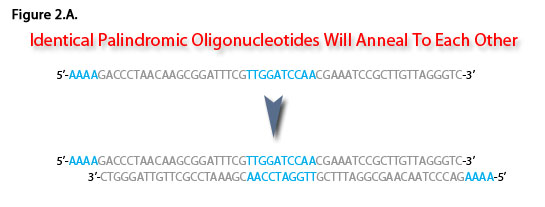| Our pLV-RNAi Vector is Ready-To-Use |
| -No restriction digestion or vector purification is required. Also, the pLV-RNAi is a self-inactivated (SIN) vector carrying a deletion in the U3 region of the 3’ LTR, which eliminates the promoter activity of LTR. The self-inactivating deletion provides an additional level of safety by preventing the integrated viral genome from generating full-length lentiviral RNA. |
| Reduced Cloning Complexity |
-Our single-strand DNA oligo encoding shRNA sequence is a perfect palindrome, thus (two) palindromic oligos can anneal to each other to form a double-stranded oligo. This eliminates the need to mix and anneal two different DNA oligos and reduces operational mistakes during the cloning process. The overall chance of mutations introduced during DNA oligo synthesis is reduced by 50% (Fig. 2A).

Example of single oligonucleotide RNAi technology: two identical DNA oligos anneal to each other to form a double-strand oligo with 5’-AAAA overhangs. The single-strand oligo encodes 21-nt sense target sequence, a 10-nt loop sequence (TTGGATCCAA), and 21-nt antisense target sequence. |
|
| Low Cost |
| -Only one DNA oligo is required to generate an shRNA expression clone. This setup is the most economical, and is distinguishable from all the other shRNA vectors commonly used in academia and industry, for which two different oligos are needed to make an shRNA expression clone. Also, the length of the DNA oligo used for pLV-RNAi (52-56 nt) is shorter than the length of the DNA oligos required for most of the other commercially available shRNA vectors. |
| Highly efficient, Low Background shRNA Cloning |
-The 5’-AAAA overhangs on annealed double-strand oligo can only be ligated to the 5’-TTTT overhangs on both ends of the linear pLV-RNAi vector. Unlike the overhangs generated by restriction digestion in other available shRNA expression vectors, these 5’-TTTT overhangs in pLV-RNAi will not self-ligate. As a result, the ligation of the double-strand oligo into the pLV-RNAi vector is highly efficient, and the contamination of empty, self-ligated pLV-RNAi vectors is greatly reduced (Fig. 2B).

The 5’-AAAA overhangs of an annealed double-strand oligo can only ligate with the 5’-TTTT overhangs on the pLV-RNAi vector, which greatly increases the ligation efficiency and reduces the background of cloning. |
|
| Your choice of three promoters for shRNA and selectable marker expression |
| The shRNAs can be expressed from human H1 (H1), human U6 (hU6), or mouse U6 (mU6) promoters in the pLV-RNAi system. Researchers are able to choose the pol III promoter most suitable to their model system. In addition, the pLV-RNAi system offers choices of various pol II promoters, which drive different expression levels of the selectable makers in the model system of your interest. |
| High efficiency in delivery and long-term suppression |
| -Lentiviral transduction is considered to be one of the most effective delivery systems for RNAi expression, especially in primary cells and some cancer cell lines that are difficult to transfect by conventional methods. The lenti-shRNA viral genome is integrated into the host chromosomes, and thus, the shRNA is stably expressed in transduced cell lines. Also, unlike the retroviral system, the lentiviral integration is cell cycle independent. The shRNA encoded by the lentivirus can be efficiently delivered into both dividing and non-dividing cells. The selectable markers (i.e. Puro, Bsd, GFP, RFP, Bsd-GFP, and Bsd-RFP) allow users to generate stable cell lines with long-term suppression of genes of interest by antibiotics selection or fluorescence-activated cell sorting (FACS). |


